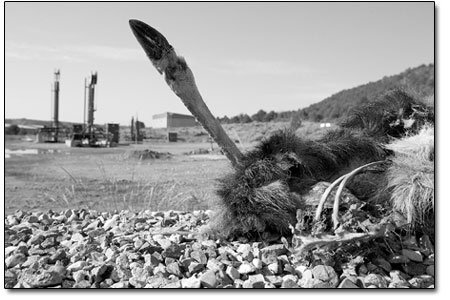|
| ||
| Renewing the landscape SideStory: Bringing energy to the table
by Will Sands Energy and environment have long been at odds in the West. However, a major push is now on the road to reversing that trend. As the era of extractive carbon-based energy passes on, conservationists and politicians are working to ensure that renewable energy leaves a lighter mark on the earth. Wildlife is often hardest hit when drill rigs set up shop or new transmission corridors are built. The current picture in the West is not pretty. The combination of human growth and climate pressures has many biologists fearing a sixth mass extinction, where rats, cockroaches and other urban species are expected to take the place of lynx, raptors and sensitive species. “There’s less and less space every day for wildlife,” said Monique DiGiorgio, conservation strategist for the Durango-based Western Environmental Law Center. “Looking at the big picture in the West, the state of our wildlife is not good. Between energy development, an expanding transportation network and suburban sprawl, habitat is getting more and more fragmented.” Recognizing this pressure and the potential for mass extinction, the Western Governors’ Association recently undertook an ambitious effort to preserve and protect critical wildlife corridors. The association, which represents 19 member states, adopted a Wildlife Corridors Initiative in June and created a Western Wildlife Habitat Council to oversee hundreds of recommendations for preserving crucial wildlife corridors. “This is really one of the most important steps I’ve seen from any governmental body on the importance of wildlife corridors and the role they play in our Western heritage,” said DiGiorgio. And as carbon-based energy wanes and renewable energy steps into the void, the association is taking an innovative step to ensure that wind and solar farms do as little environmental damage as possible. The potential impacts are significant. More than 119 million surface acres of public land in the West has been deemed as ideal for solar energy generation. In the last few years, more than 130 proposals for solar farms covering more than 1 million acres have been filed. In addition, new or expanded transmission corridors will have to be created to move this energy. “We now have an opportunity to shape the renewable energy economy in the West,” said Tom Darin, attorney with the Western Resource Advocates. “We need to get to that greater good while at the same time ensuring that we protect and preserve our landscape.” Darin noted that eight of 11 Western states have passed legislation requiring substantial commitments to renewable energy. The boom in renewables is coming, he said, and now is the time to manage impacts. “Hopefully, we can bring a more balanced energy picture to the West and impact the landscape in a very minimal way,” Darin said. “We can do that by getting involved in the process and taking hard looks at generation and transmission.” Without proper planning, two normally compatible interests could be at odds, noted Matt Kenna, an attorney with the Western Environmental Law Center. If renewable energy efforts bring a host of impacts with them, conservationists could swing into an opposing role. “Energy development in the past has really been centered around a conflict between carbon-based extraction and wildlife and the environment,” Kenna said. “We want to make sure that doesn’t happen with renewables. We don’t want to get into a position where the conservation community is opposing renewable projects because of their environmental impact.” Mitigating these impacts will begin at home, according to Kenna. While solar, wind and geothermal energy seem like easy answers to diminished fossil fuels and global warming, the new energy economy will begin with conservation. “If you don’t have conservation and efficiency, all you’re doing is increasing the supply,” Kenna said. “You need to make sure that a wind farm isn’t just another way of feeding our appetite for energy.” As renewable energy picks up steam, the Four Corners region will be at the center of these discussions. The region’s abundant solar and wind resources have already gained the attention of renewable energy companies. In addition, the Four Corners has been spotlighted for several new or expanded transmission corridors, which would move the new green energy to consumers all over the West. “The Four Corners has obvious solar and geothermal potential,” Darin explained. “The area has also been targeted for a number of years to transmit a variety of energy sources to areas like Las Vegas, Phoenix and even California. With that in mind, the area’s residents need to be involved in this process.” DiGiorgio took the thought one step further and added, “We’re really in the solar hot spot for the nation. But now’s the time that we discuss how we’re going to do these projects and discuss how we’re going to do them properly.” •
|
In this week's issue...
- May 15, 2025
- End of the trail
Despite tariff pause, Colorado bike company can’t hang on through supply chain chaos
- May 8, 2025
- Shared pain
Dismal trend highlights need to cut usage in Upper Basin, too
- April 24, 2025
- A tale of two bills
Nuclear gets all the hype, but optimizing infrastructure will have bigger impact


